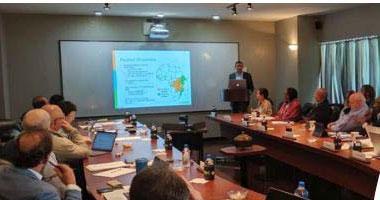3 emerging technology trends for bankers

Dominic Venturo,
Executive Vice President, Chief Innovation Officer,
U.S. Bank
I’ve been following new technologies in the banking industry for many years, watching them disrupt long-established processes. Every new device linked to the internet represents another venue for customer interaction — and another potential headache for IT and security departments.
The pace won’t slow down, so it’s crucial to understand these new trends and integrate them when it best serves your business. At a recent commercial real estate (CRE) conference, I spoke about some of the most visible trends, and how they stand to alter the course of banking as we know it.
Key innovation focus areas
My innovation team at U.S. Bank identified the following areas as top innovation priorities:
• Digital identity
• Big data
• Distributed ledger
• Developer portals and application program interface (API)
• Location-based services
• Internet of Things (IoT)
• Artificial intelligence (AI) and machine learning
• Biometrics
• Employee tools
• Customer experience
Each of these areas varies in maturity, though all have the potential to shake up banking systems. Many already do, thanks to increased consumer adoption of smart devices for transactional management.
In my speech to the CRE audience, I focused on three specific areas:
• Employer portals and API
• Distributed ledger
• Artificial Intelligence
These three alone give bankers immense potential with their customers — though only when implemented effectively within their current infrastructures.
The future of banking is in the open (API)
Jim Marous, from The Financial Brand, said it best: open banking APIs offer potential “far beyond traditional banking, including all of the services a consumer may want in a digital world.”
Banks have used APIs for years, though primarily through private networks or with formal third-party partners. The open banking trend could force banks to align with third parties that aren’t formal partners — like financial technology startups. I’ve spoken about the complicated relationship between banks and these firms before. It could benefit banks to build a better relationship through open APIs — and provide more options for customers to do business.
In general, API development allows organizations to:-
• Enable connectivity with other systems, and integration into a larger data environment
• Simplify development, allowing for more customization
• Broaden integrations with legacy systems
• Pursue new distribution channels
• Generate new customer insights
• Maintain (and sometimes improve) customer privacy and security
More specifically, banks and their customers can use APIs for everything from payment instructions, accounting system integration, to issuing rebate cards. Even the age-old system of check printing can receive a boost from open APIs.
Blockchain and beyond: distributed ledger graduates beyond Bitcoin
I’ve made multiple references to distributed ledger technology in my recent presentations, and it remains one of the most disruptive methods for transactional and process management.
Distributed ledger can improve speed and visibility by removing intermediaries from the transactional process. Since there’s no central clearing house within a ledger, the network itself decides whether or not to approve transactions. How this happens varies by network type, a good topic for a future discussion.
They provide a universally accepted, unchangeable and cryptographically secured record of all transactions and events. The Blockchain and Bitcoin brought this technology to the forefront, but banks now use versions of it to keep record of more regulated transactions.
From a CRE perspective, distributed ledger could be used to simplify the contract process. Organizations can develop “smart contracts” that use distributed ledger for data verification and automatic enforcements:
• Data driven verification
• Data are verifiable and the contract terms are known within the ledger record, and all parties can view proof of performance
• Automated enforcement
• If desired, contracts can execute when conditions are met, eliminating reliance on other parties
• Data are securely stored and auditable in a ledger
• Immutable nature of ledger provides transparency from beginning to end (to those with permission to view it)
Distributed ledger now stretches to multiple aspects of modern banking, including capital markets and trade financing. Banks and organizations will need to determine the best ways for their business and customers to adopt this emerging technology.
Machine learning and AI: More than just an Echo
When my team thinks of artificial intelligence, it lives within a broader category of computer science innovations. AI by itself can encompass several aspects, including the following:
• Virtual personal assistants such as: Amazon Echo, Google Home, Apple Siri
• Natural language processing: The ability for a computer to understand human spoken language
• Computer vision: How computers can gain information from digital images or videos
• Machine learning: How computers can learn to act without being programmed
• Recommendation engines: Predict relevant user behavior based on past actions (of a user, or other cohorts)
• Advanced process automation: Tools to further automate industrial processes within a control system
Banks have generally limited their AI activities within specific domains or business verticals. As data rapidly increases and computers perform more computational tasks than ever before, my team focuses on elevating these tools for more widespread use.
The technology will only get better
These three trends represent a small segment of the innovation space. Within them, new advancements are developed every day. Not every innovation will work for an organization, nor should organizations jump to adapt when something new arrives. But it’s crucial to understanding the potential of these new innovations, because the cycle of disruption never stops.
Subscribe to Industry Era
News
This Apple Watch Case Could Kill All of Those Wannabe AI Devices
Google defends AI search results after they told us to put glue on pizza
Google scales back AI search answers after it told users to eat glue
FAA won't approve increased 737 Max production in near future
Thursday was a sour day for the US economy — with an important silver lining
OPEC+ working on complex production cut deal for 2024-2025, sources say
Stock futures inch lower as investors review earnings, brace for inflation report: Live updates
Salesforce Shares Plunge by Most Since 2008 After Weak Outlook
Jeep’s Wagoneer S Trailhawk concept teases a fully electric off-roader
Gap’s stock jumps 23% as the retailer swings to profit and raises guidance
Medline recalls 1.5 million bed rails linked to deaths of 2 women
Oil falls as Fed policymakers look to maintain rate cuts, gasoline stocks rise










